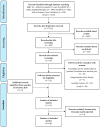Parental Correlates of Outdoor Play in Boys and Girls Aged 0 to 12-A Systematic Review
- PMID: 30641874
- PMCID: PMC6351982
- DOI: 10.3390/ijerph16020190
Parental Correlates of Outdoor Play in Boys and Girls Aged 0 to 12-A Systematic Review
Abstract
Outdoor play is one major source of physical activity (PA) in children. In particular, parents act as gatekeepers, because they can enable their children's outdoor play. This systematic review aims to provide an overview of parental correlates of outdoor play. A systematic literature research of six electronic databases (ERIC, PsycARTICLES, PsycINFO, PubMed/Medline, SCOPUS, and Web of Science Core Collection) was conducted with previously defined search terms, focusing on children 0⁻12 years old. In total, 1719 potentially publications were screened based on eligibility criteria. Included studies were scored for overall study quality. Findings were summarized using a semi-quantitative method. Twenty-one peer-reviewed publications which examined the relationship of parental correlates and outdoor play were included. Overall, five parental correlates were associated with children's amount of outdoor play: mothers' ethnicity, mothers' employment status, parents' education level, the importance parents assign to outdoor play, and perceived social cohesion in the neighborhood. Merely four studies reported sex/gender-stratified results. In summary, only parents' encouragement/support provided evidence for girls' amount of outdoor play. The findings are considered to be of public health relevance for developing intervention programs to increase outdoor play and for improving child's health. More research, especially considering sex/gender of the child, is required.
Keywords: children; gender; neighborhood; outdoor play; parental correlates; perceptions; physical activity; restrictions; safety; sex.
Conflict of interest statement
The authors declare that they have no competing interests.
Figures


References
-
- Tremblay M.S., Carson V., Chaput J., Connor Gorber S., Dinh T., Duggan M., Faulkner G., Gray C.E., Gruber R., Janson K., et al. Canadian 24-Hour Movement Guidelines for Children and Youth: An Integration of Physical Activity, Sedentary Behavior, and Sleep. Appl. Physiol. Nutr. Metab. 2016;41:311–327. doi: 10.1139/apnm-2016-0151. - DOI - PubMed
-
- World Health Organization Physical Activity—How Much of Physical Activity Is Recommended? [(accessed on 15 May 2018)]; Available online: http://www.who.int/en/news-room/fact-sheets/detail/physical-activity.
-
- Faulkner G., Mitra R., Buliung R., Stone M. Children’s outdoor play time, physical activity, and parental perceptions of the neigbourhood environment. Int. J. Play. 2015;47:84–97. doi: 10.1080/21594937.2015.1017303. - DOI
Publication types
MeSH terms
LinkOut - more resources
Full Text Sources
Medical

